Simon Blackwood Fine Arts
Restoring Works on Paper
Papers by Post
Works on Paper are easily and safely transported by courier and post, and we have many clients throughout the UK and abroad. It is also possible to give good information about Works on Paper by e-mail or over the telephone. A good description of the condition of the item and/or a jpg photograph will help us to make relatively accurate "unseen" estimates of procedures and costs.
Simon Blackwood Fine Arts has over 35 years experience in the restoration of works of art on paper. Distance is no object as most Works on Paper are easily and safely transported, borne out by our many clients throughout the UK and abroad.
All the techniques mentioned here are dealt with daily in our studios, including archival mounting and presentation.
Please see our terms and conditions if you are unfamiliar with restoration processes.
Works on paper fall into two main categories:
The first category includes watercolours, gouache, postercolours, pastels, drawings and collage.
Damage can be caused not only to the paper they are applied to but also to the physical structure of these media, which may be disturbed or altered by excessive moisture or chemicals.
The most likely cause of discolouration other than light – what is known as "foxing" – affects the paper which the painting or print is applied to and is rarely, except in extreme cases, damaging to the pigments. (The origin of the term "foxing" is unclear but possibly refers to the reddish-brown colour of the stains? This is not the same as iron marks (see below) but is often used as a general term for staining that appears as reddish spots.)
The paper "support" demands care and respect for its potential fragility. Most watercolour papers, however, are very robust amalgams of cotton fibres and gelatine size. Therefore the measures needed to remove staining require the use of benign chemicals in both aqueous and non-aqueous form which will not deteriorate this well-designed bond created by the paper maker. In most cases it is best practice to avoid allowing excessive contact with water, particularly watercolours of recent origin as the pigment binder (gum arabic most often) may release its adhesion. Various methods are available to the experienced conservator who will be able to test the paper structure and pigment age. The use of any "bleaching" solution is not recommended without this experience. Foxing and staining can, however, be eliminated successfully without any deterioration of the paper support or pigment binding.
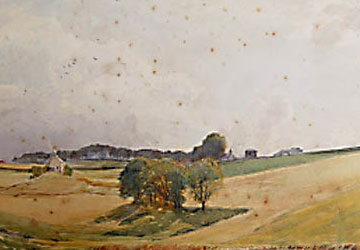
Impurities in the rag paper of this Tom Scott watercolour have reacted with moisture in the atmosphere causing stains known as "foxing".
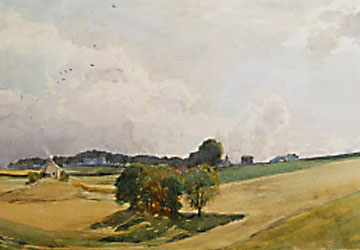
Some of the marks in this Tom Scott watercolour, treated for foxing, are revealed as birds.
Paper constantly absorbs moisture in the atmosphere and with it any impurities it might carry. Wooden backing boards, commonly used before the invention of masonite, museum board etc., discharge resins which stain the paper next to them. The effect is often noticeable as brown lines cast across the image exactly where the boards join.
Impurities in the paper itself – particularly early rag watercolour paper – cause spots to appear (iron marks), some of which may be fragments of metal buttons used in the past for gentlemen's shirts etc.
The second category includes most printed media such as lithographs, etchings, engravings and silk-screen. (Photographs are not covered here.) The chemical make-up of most of the types of printed image is rarely affected by moisture. It is mostly deterioration or staining of the paper support which requires restoration treatment.
The most common cause of discolouration of works on paper is exposure to light. Fugitive (light sensitive) pigments used in any of the techniques mentioned here, can fade if exposed to direct sunlight for long periods.
Prints are often made onto paper which is inferior to that manufactured for watercolours and drawings. Although generally, it is affected in much the same way, by moisture, it can also discolour due to the type of pulp used.
Wood-pulp paper can turn brown with age and if the binding agent (gelatine size) is weak the paper may become fragile and difficult to treat.
Prints made onto thin papers are invariably laid down with glue onto inferior card for strength. These backing cards and the glue itself may have many more impurities than the print paper and will transfer rapidly to the printed page. In most of these cases restoration is possible. Careful chemical treatment of the paper, after analysis, is often completely successful.
Pastel paintings and drawings
Pastels consist of pure pigment powder blended with an inert binding solution that is rolled or pressed into a stick. The type of binder and its proportion to the amount of pigment powder used determines the hardness or softness used for different techniques.
This medium has been in use since the 16th century and as with all artistic techniques there are many variations on its application.
The most common support is textured paper or card, as the pastel sticks need a "tooth" (grain/texture) to adhere to. (This doesn't mean that artists have restricted their use to these supports, as any textured surface will accept pastels.) The marks made onto the support leave pure mineral pigment residues that only permeate the fibres on the surface or just lie upon it, thus making the resulting painting relatively fragile.
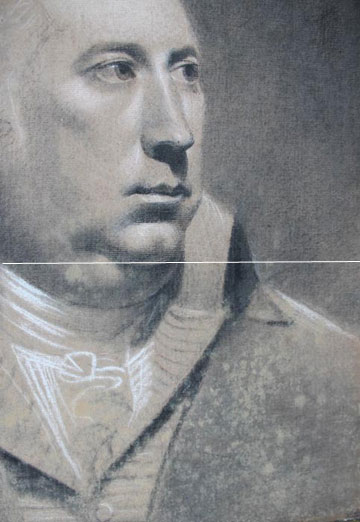
Above: Portrait of a gentleman in pastel and chalk. The lower section of the image shows the effects of water damage and condensation where the drawing was framed too close to the glass.
Each grain of mineral pigment placed in this way, visually absorbs and reflects light from its entire surface unhindered by any refraction from glutinous emulsion or oil binders. It is because of this that pastel paintings have a brightness and often vivid colour that doesn't fade or yellow with age even when exposed to bright sunlight.
The problems the restorer faces are the atmospheric effects on the support, the quality of the support or, when left unframed, the accumulation of dust and other particles. Damage is also caused by: the removal of pigment particles during inexpert handling, framing the painting too close to glass (static electricity can "pull" pigment away from the support onto the glass), hanging in such a way that falling pigment particles land on other areas of the work, or by exposure to excessively damp or humid conditions. Fixatives applied either by the artist or later by hapless framers or restorers to stop the loss of pigment or the nuisance of falling grains spoiling a clean mount affect the brightness of the painting by dulling the reflective quality of the minerals. Pastel artists have used many different kinds of fixative as a way of allowing fresh layers of pigment to be drawn or dragged over those beneath, but most often the last layers will not require fixing to realise the final effect.
Pigment particles will inevitably fall from the painting during its lifetime, even in museum conditions, as this is part of the nature of the medium. The fragility of the technique is also its beauty and so restoration and framing demands the attention of those who are experienced in dealing with pastel paintings.
Below: The Seine outside Paris – 19th century pastel painting. Mould growth formed around various organic fragments in the pigment, binder or paper, caused by excessive humidity exacerbated by condensation.
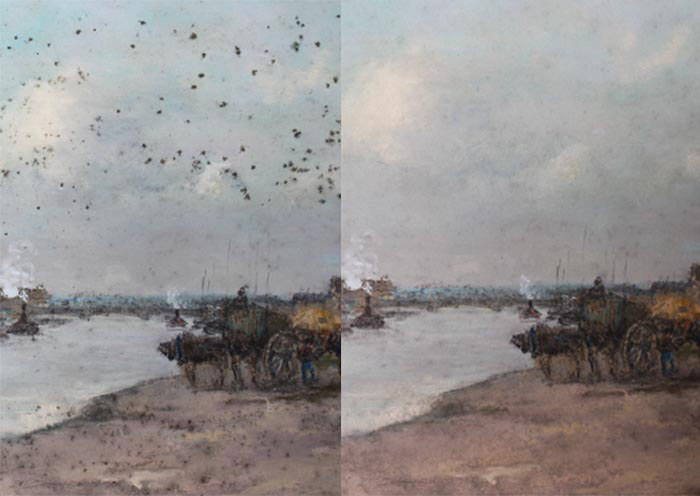
How to do it
To get an idea of what can be achieved for your particular work on paper please contact us first by e-mail or telephone.
E-mail inquiries are usually answered within 24 hours.
A good description of the condition of the item and/or a jpg photograph will help us to make relatively accurate "unseen" estimates of procedures and costs.
These costs are related to the treatment required in each case and not to the value of the artwork.
The scale of charges corresponds to the size, the presence of additional fixtures like backing card and/or aperture mounts and any glue residue that may have to be removed prior to treatment.
Packaging
We have advised the following to our clients as a simple and proven, safe method of packaging:
Example: Paper size 17" X 13"
Place a protective film (tissue paper) around the artwork. Do not use cellotape or similar petroleum-based glue tapes near the artwork's paper. Pack between two sheets of strong card, slightly larger than the watercolour/print/drawing paper size (17.5" X 13.5"), like a sandwich (we use foamcore card) secured with tape.
Put into a jiffy bag, or similar, with dimensions as near as possible to the sandwich size and forward to the address at the bottom of this page. (Jiffy bags will protect the package from potential water damage in transit so any other form of packaging should also have a protective outer layer of polythene or similar.)
Watercolours, pastels or drawings are best forwarded this way whereas stable prints can be rolled into a tube with the image side outermost and covered in tissue paper or similar with an outer layer of polythene. (Please try to use as large a diameter tube as possible.)
- If the artwork already has a fixed aperture mount and backing card include these in the packing.
- For much larger images it is necessary to enclose the card sandwich in a sealed, protective polythene envelope before wrapping in parcel paper (brown paper).
- For extra safety an MDF (hardboard) sandwich is recommended especially for overseas shipping. (We use foamcore card to reduce weight.)
Transportation
Transportation is fast, easy and reasonably cheap within the UK using Royal Mail special delivery – guaranteed 24 hour arriving by midday the next day (Insurance/compensation may be up to £2,500) although many of our clients use the more economical registered post.
Parcel Force offers the same service.
Overseas clients have found their own postal services satisfactory and comparably cheap. USA clients must make sure the contents are marked for restoration and return to avoid unnecessary import VAT.
Artwork with a value greater than £2,500 can be sent by carrier both within the UK and Worldwide.
Please never enclose glass but should you need to send artwork within the UK that has a frame in need of restoration we recommend Aardvark Art Movers. (Speak to Isobel on 0125 - 379 4673 or e-mail aardvarkart@talk21.com).
If you are in any doubt about any of the above contact us:
by e-mail simonblackwood@btconnect.com
or telephone 01450 870870 9am – 6pm GMT
Full postal address:
Simon Blackwood Fine Arts
The Studio
Wells Old Lodge
Bedrule, Near Hawick
Roxburgh, Scotland UK
TD98TD
Gallery examples
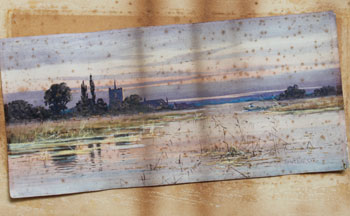
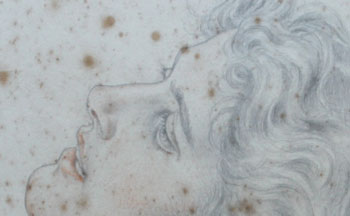
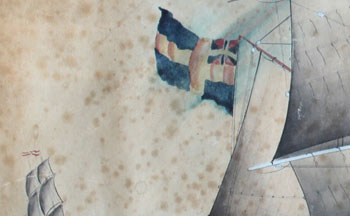
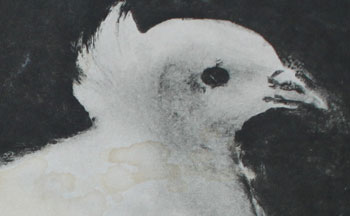
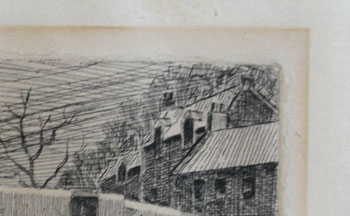
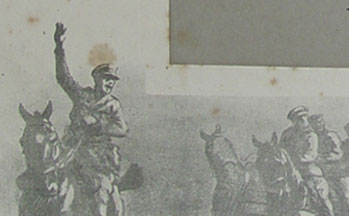
A turning point in paper making
For a unique record of the history of the development of the wove (velin) paper industry documented in a three-volume work by John Balston, please go to: www.wovepaper.co.uk Paper conservationists will find this work of great value through the insight it gives into the manufacturing process up to the early 19th century together with the materials involved.